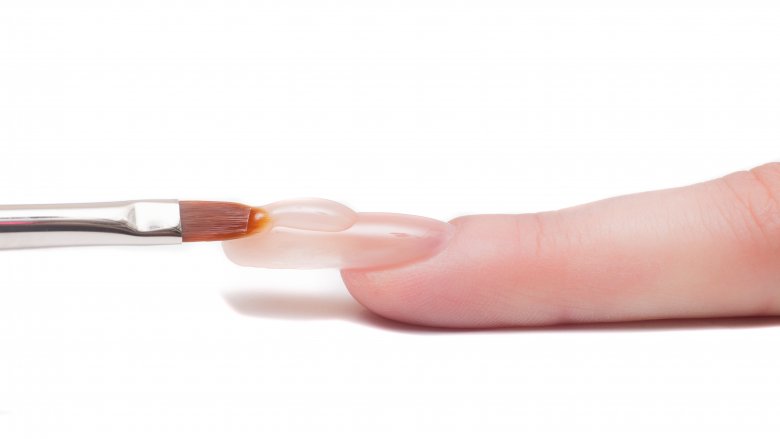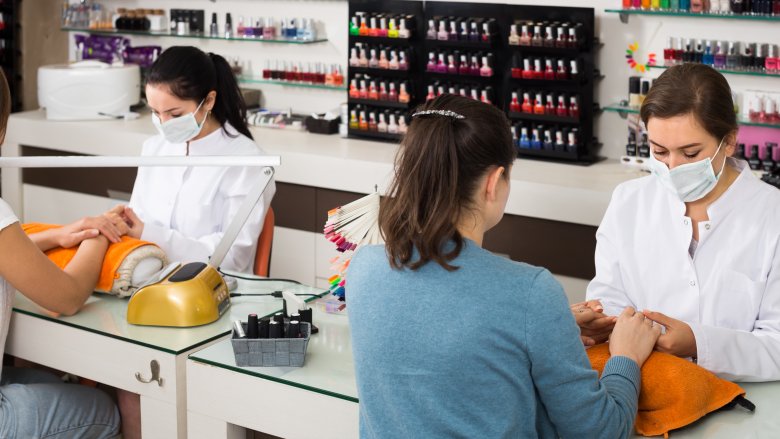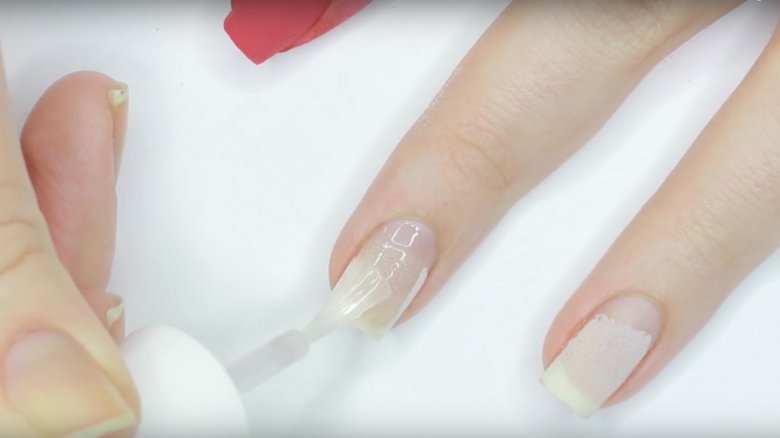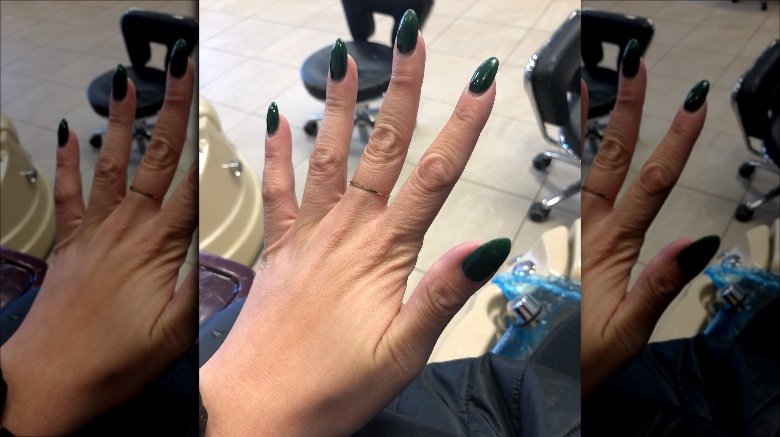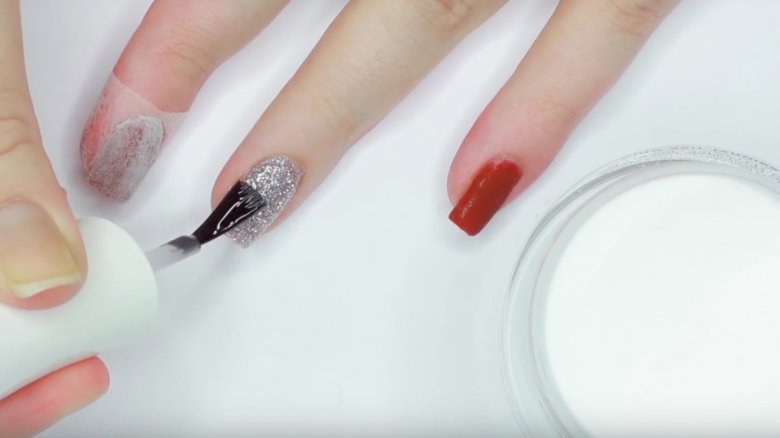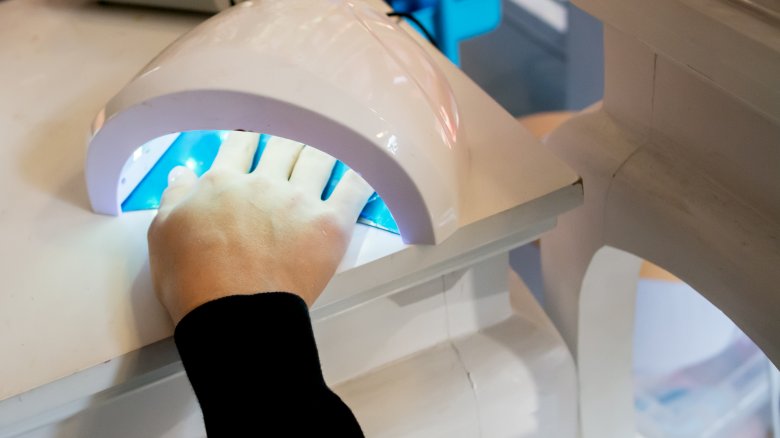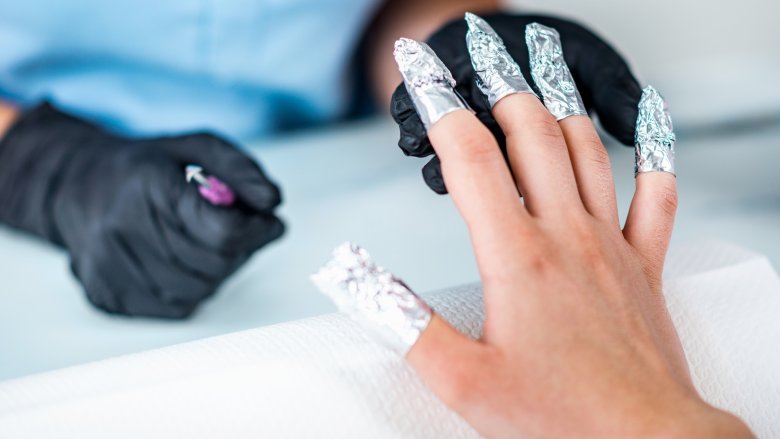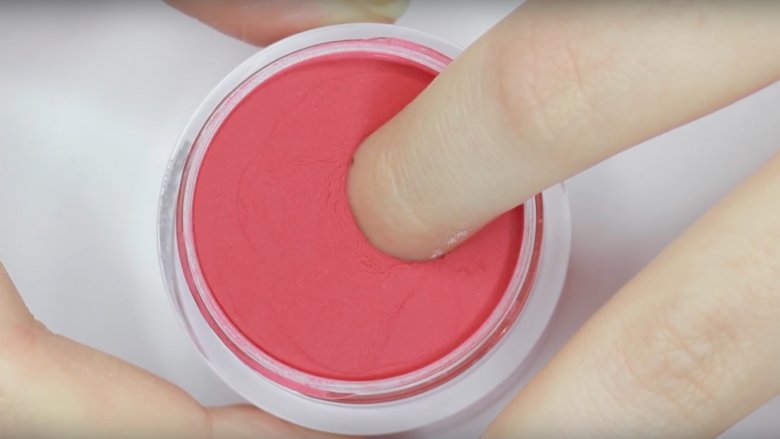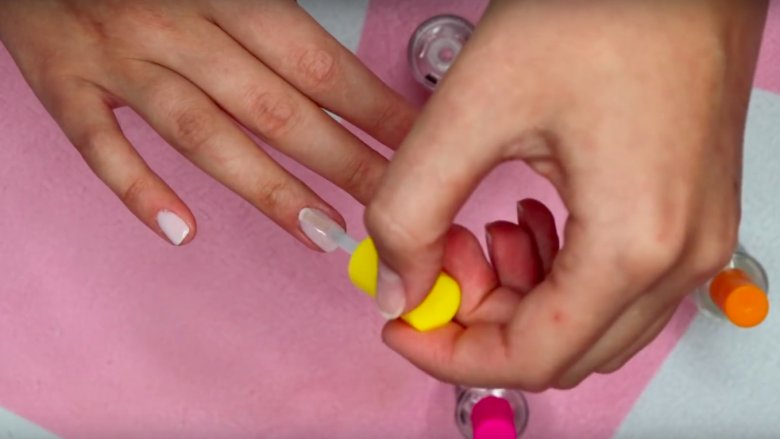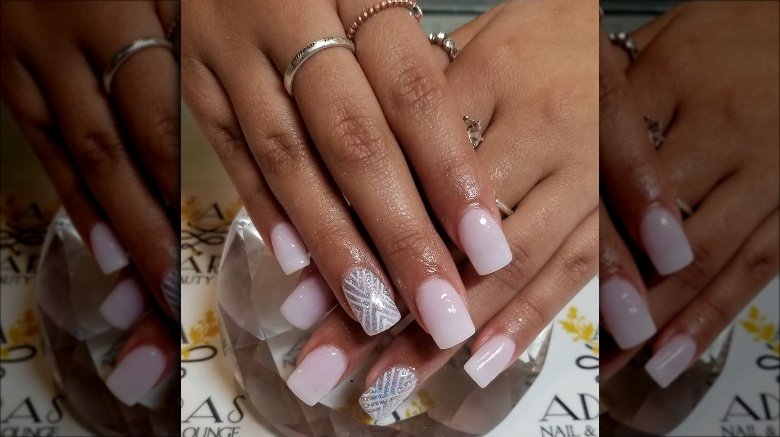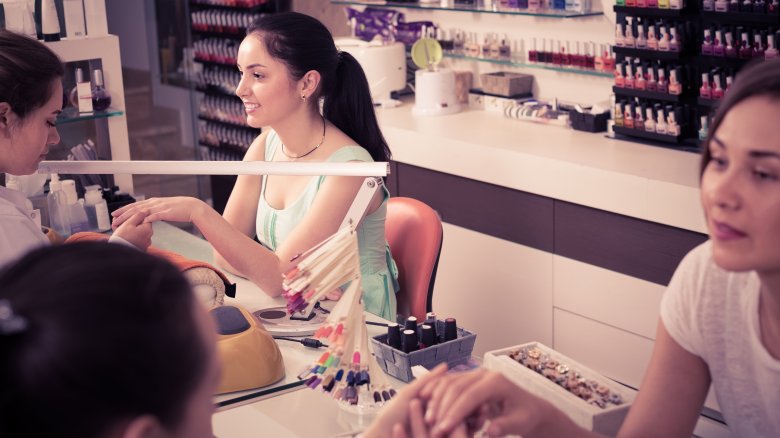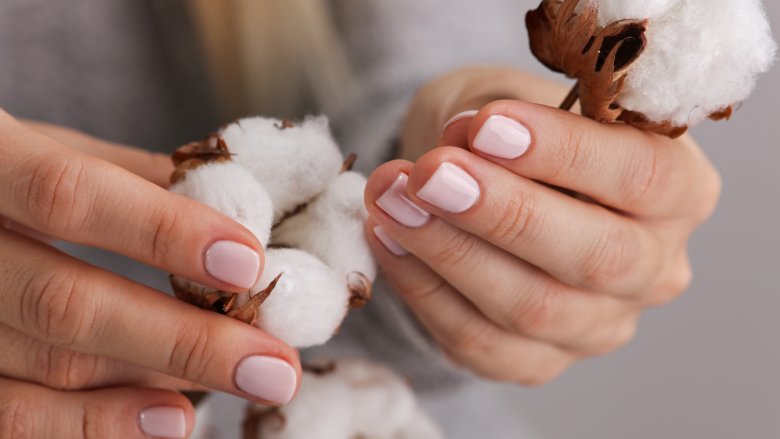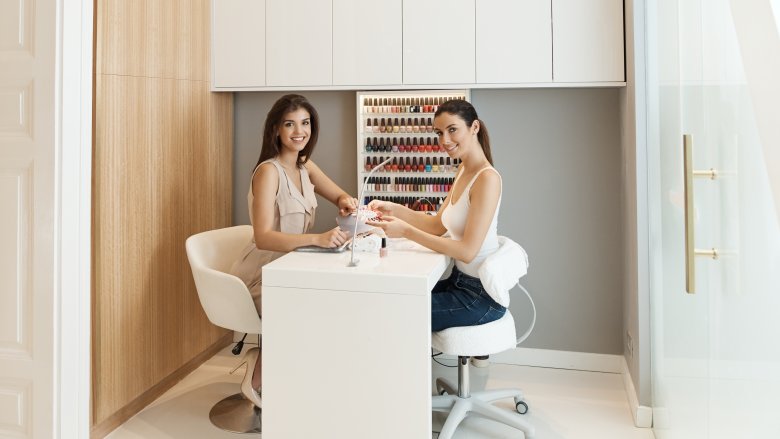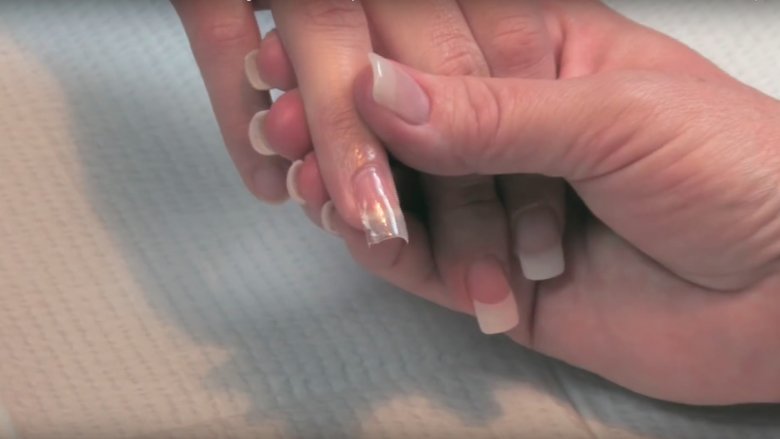What You Should Know Before Getting Dip Powder Nails
Just as with fashion, nail trends tend to come and go. Michelle Humphrey, the phenomenal nail artist who works with celebrities like Lorde and Dua Lipa, shared some of her favorite 2019 manicures with Elle. If adventuring with bold colors is your thing, you're in luck. "Lollipop and gummy bear tones" are one look well-suited for spring. If you're not into all of the intense colors, Humphrey recommends trying a subdued yellow shade, like mustard. Even with bold nails being such a hot look in 2019, colorless nails can be just as fun — especially if you opt for high-gloss transparent nail extensions.
In addition to choosing the perfect color, there are other nail options to consider — especially when getting artificial nails. You can select your ideal shape from square to almond and everything in between. You even get to choose your material, which may just be the most difficult part. From gel to acrylic to the increasingly popular — and perhaps most controversial — type: dip powder. Wondering what all the hype is about? Here's everything you should know about dip powder nails before you even think about getting them.
They're still acrylic
"Fake" or artificial nails, no matter which kind you choose, all share a common base. "All of the ingredients used to make any type of artificial nail — whether they be glued, cured by UV, or mixed with a liquid and powder — are based on the acrylic family," Doug Schoon, a chemist, co-chair of Nail Manufacturer's Council, and the president of Schoon Scientific and Regulatory Consulting, told Self.
The popular nails that have been assigned the name "acrylic" are made by fusing together a liquid and a powder to create a gel-like substance. "Gel" manicures are really much the same, but they come in a ready-to-use gel form and are cured, or hardened, by placing the nails under UV light for at least a few minutes. While the "dip powder" may seem revolutionary, especially at first, it's really not all that different from the other types. The technique gets its name because, after applying the bonding agent, the nails are then dipped into a colored powder of your choice and finished off with a sealing top coat.
A diet acrylic?
While dip powder manicures are still acrylic, celebrity manicurist Erica Marton told Glamour they're more like a "diet acrylic" because they're sort of an in-between version of a regular, painted manicure and artificial nails. You may think this makes dip powder a better choice than a traditional acrylic manicure, and, in theory, that makes sense. Unfortunately, that's not the case.
Ariel Zuniga of Vanity Projects nail salon in New York takes issue with the bonding used in dip powder manicures. According to her, it's "a very cheap product, oftentimes containing MMD, which is extremely harmful to natural nails and banned in NYC." MMD, more commonly referred to as MMA, is methyl methacrylate — and it's not just banned in New York. Over 30 states have banned the professional use of the substance.
Reader's Digest advises asking your nail technician about their products before getting your nails done. You can often tell if MMA is being used by its chemical smell, which is "sharp and fruity," according to the publication. It won't smell like other liquid acrylics. Also, if your nail tech puts on a mask before applying the bonding agent, that's an indication that the product is unsafe.
They contain this Krazy ingredient
If you do your due diligence and visit a reputable salon, you hopefully won't have to worry too much about methyl methacrylate being used in dip powder manicures. Nevertheless, it might surprise you to know that the legal bonding agent used in dip powder is cyanoacrylate. No? Doesn't sound familiar? Essentially, it's Krazy Glue. While your nail tech isn't actually painting Krazy Glue on your nails — at least we hope not — both products do contain the same main ingredient: cyanoacrylate.
According to Krazy Glue's website, cyanoacrylate was used to stop the bleeding and close the wounds of injured soldiers during the Vietnam War. While the brand states that this is obviously not the intended use of Krazy Glue today, cyanoacrylate is still formulated for medical use. Chemist and nail expert Doug Schoon revealed in an article on his site that "cyanoacrylate monomers (aka resin) are great for many purposes in nail salons." Hmm, not so Krazy after all.
Nail dips aren't new
Although dip powder manicures may seem like a new trend, they've actually been around for quite a long time. Denise Gottschalk, owner and nail technician at Nailz "T" Go in Laurium, Michigan, told Nails Magazine that she first learned of an acrylic dip system in 1997, just a few years after she graduated from nail school. While on vacation, she needed a nail fill and went to a nearby salon. There, the technician filled her nails using dip powder. Gottschalk was sold.
Although she had not been taught about dip systems in school, they predate the late '90s by a bit. According to the publication, dipping nails was actually the go-to manicure in the early 1980s — when other acrylic systems were only just coming out.
Dip systems would take a backseat for a time, which is a shame for nail technicians because they're a whole lot easier to apply than acrylic or gel nails. Ricky Huynh of Amazing Nail Concepts in Wellington, Florida, explained to Nails Magazine, saying, "The learning difficulty isn't as high because there is no need for acrylic brushes to build the nail, no lamps, electric fans, or French cutting tools."
They don't take as long to apply
Dip powder manicures, and even their retro dip system ancestor, win when it comes to how long they take to apply. "Dip nails don't require UV/LED light and are typically a much quicker process to apply from start to finish, licensed nail technician Harli G. revealed to Elle. And, let's be honest, waiting for your nails to dry is like, well, watching paint dry. It's the most boring, and yet arguably most important, part of acrylic and gel manicures.
The ability to apply them quickly was what got nail salon owner and technician Denise Gottschalk interested in dip systems to begin with. "I was fascinated that the nail tech did my fill in 30 minutes. I even hung around to watch her do a full set in under an hour," Gottschalk said of her first experience with the original dip system. The ease and speed of application combined with their fun name only increases what dermatologist and nail specialist Dana Stern dubbed their "Instagramability."
You don't have to worry about skin cancer
As nail technician Harli G. told Elle, there's no need to put your hands under UV light after getting a dip powder manicure. Not only does that save you some time at the nail salon, it also eliminates the risk of skin cancer that comes with gel manicures.
Although the chance of getting skin cancer from the UV lamps used at nail salons is relatively low, one study (via Reuters) found that the lamps caused damage to skin cells, which is a potential precursor of skin cancer, after anywhere from eight to 208 visits. On average, 11 visits to the nail salon would be enough to increase your chances of getting skin cancer.
"I wouldn't tell a patient to stop going unless they were going multiple times a month," the study's lead author, dermatologist Lyndsay Shipp, told Reuters. Instead, she and her team recommended wearing sunscreen on your hands when heading to the salon. Of course, with dip powder nails, you can skip the sunscreen and skin cancer risk altogether.
They can take longer to remove
What you likely won't see while scrolling on Instagram is the process of removing dip powder nails. That part isn't exactly Instagram-worthy, but it is something you should be aware of. As it happens, all of the time you thought you'd save during the application is more than made up for during removal. Just as with gel manicures, soaking is required to remove a dip powder manicure.
"One thing that people don't understand is that if it says soak for fifteen minutes to remove, that's the minimum time," nail expert Doug Schoon told Self. "It may be fifteen minutes if you take them off the same day [as application], but if you wait two weeks or four weeks, it could take thirty minutes." Yikes. Still, it's important to keep on soaking because trying to scrape off your manicure — even if you think you're doing it gently — is a bad idea. "That's like saying I punched you gently in the nose," Schoon added.
You shouldn't actually be dipping your nails
Dip powder is a bit of a misnomer. Or, rather, it should be. Despite how it cool it looks in Instagram videos, you should never, ever dip your nails into a jar of powder at a salon. "It is incredibly unsanitary for multiple clients to dip their fingers in the same container of powder, even pouring the product over multiple clients' nails and allowing the product powder to fall back into the container is an easy way for nail infections to be passed between clients," nail technician Harli G. explained to Elle. "If you notice techs applying the dip powder in either of those ways, LEAVE and go to a different salon."
Nail expert Doug Schoon agrees. On his site, he revealed that having multiple clients dipping their fingers into the same powder increases the risk of transmitting "an infectious microorganism that can lead to an infection." Yes, it's pretty nasty. If your technician pours powder — which is the most sanitary way — just be sure it's not done over a shared container.
You shouldn't do them yourself
A surefire way to avoid cross-contaminating powders is to solely use your own, right? Well, thanks to brands like SNS Nails and Revel Nail, you could certainly buy your own pots o' powder and start perfecting your manicure at home without the risk of contacting any sort of nasty infection. But, just because you can, does that mean you should? Sadly, it's probably not a good idea to start down this path.
"I would never recommend doing [gel or dip powder manicure] as a DIY at home because for both treatments, there are chemical products that can harm skin or the nail plate if not properly applied," nail technician Harli G. revealed in an interview with Elle. "Even professional grade products and products marketed for at-home use contain harming chemicals, so it's just safer to go to a salon for both gel and dip treatments."
They can last for months
One of the selling features of dip powder nails are their staying power. Nail technician Elaine Ling Lee, who works at Valley salon in New York City, confirmed to Insider that this style of manicure is indeed "a long-lasting manicure." It can last for — you might want to sit down — eight weeks. A two-month manicure? Now that may sound dreamy, but it's actually more like a nightmare. First, remember what nail expert Doug Schoon said? The longer the dip powder is left on, the longer it takes to remove. Imagine the removal time for a manicure that's eight weeks old. Eek.
It's also not good to go that long without being able to see your natural nails. Dana Stern, a dermatologist and nail specialist in New York City, told the publication, "The nail is a window into our health and so covering the nail hinders the potential ability to see if there is an issue going on."
They dehydrate the nails
Even if you don't leave your dip powder nails on for a couple months at a time, your nails are still going to be damaged. "Dip powders are temporarily damaging to the nails as the seal layer of your nails is broken in the process of this type of manicure," Josephine Allen, a nail technician at a Samuel Shriqui Salon, which is also Essie's flagship store, explained to PopSugar. "Dip powders also tend to temporally dehydrate the nails." While the damage is very real, it's not permanent. So, if you've jumped the gun and already booked your appointment, don't worry. Well, don't worry too much.
"The root of the nails will not be damaged in the process and a new layer of nail will continue to grow," Allen confirmed. Still, don't believe the claims that say dip powder is a safer or "healthier" alternative to other traditional manicures. According to the expert, it's not.
They're not the best option for this style
Your top priority when selecting a nail type may not be all about which one is better for the health of your nail — we get that. Sometimes it's just about picking the one that you like the best. Nail technician Harli G. told Elle that "gel nails tend to look a bit more natural on the nails than a dip [powdered] enhancement." As such, she personally prefers the gel.
If you're going for one of the "delicate sheer iridescent manicures" that celebrity nail artist Michelle Humphrey predicts will be on trend throughout the 2019 year, you might want to stay away from dip powder. This look, according to Humphrey, calls for "super-fine subtle glitters, not chunky or opaque." She added, "We want to see the nail plate underneath." Of course, if you're choosing something bolder, you might prefer the look of dip powder nails as opposed to acrylic or gel.
Many salons refuse to offer dip powder nails
Dip powder nails may be all over the internet, but finding a salon that offers them can be a challenge. Rita Pinto, founder of Vanity Projects, a high-end nail salon in New York City, told PopSugar that she decided not to offer her clients this kind of manicure because of the sanitation risks. Ruth Kallens, founder and partner at Van Court salon, also won't put them on the menu. As mentioned earlier, she told Glamour she's concerned that the bonding agent could contain the banned substance methyl methacrylate. But that's not the only reason. She continued, saying, "Dip powders are acrylic. I don't use acrylic because the removal process is so detrimental to your nail plate."
If you really want dip powder nails and can't find a salon that'll do it, you might be tempted to try the DIY version, which, as you now know, is also not advised. It may not be the answer you want, but if technicians are refusing to offer these increasingly popular manicures — ones that would likely be very profitable — because of the risks involved, you might want to think twice before trying it.
If you do get dip powder nails, try this
If after carefully considering the pros and cons of dip powder nails you decide you want to go through with it, nail technician Josephine Allen revealed to PopSugar that you should have a paper wrap, or nail wrap, applied to your nails first. "A manicure involving paper wrapping the free edge of the nails can last up to two weeks," the expert explained. "This manicure is healthier for the nails and it won't be roughened in the process."
According to Nails Magazine, nail wraps, just like dip powder systems, are a blast from the past. In the early 1980s, nail wraps were made from a variety of materials — linen, fiberglass, mesh, paper, silk, etc. — and applied to the nail. They're held onto the nail with resin or can be embedded right into acrylic and gels. Nail technician Vicki Peters told the site that nail wraps are a great option because they won't cause damage to a person's natural nails. When used under a dip powder manicure, it essentially works as a barrier and, since dip powders are not exactly the best for your nails, every little bit of nail protection helps.

